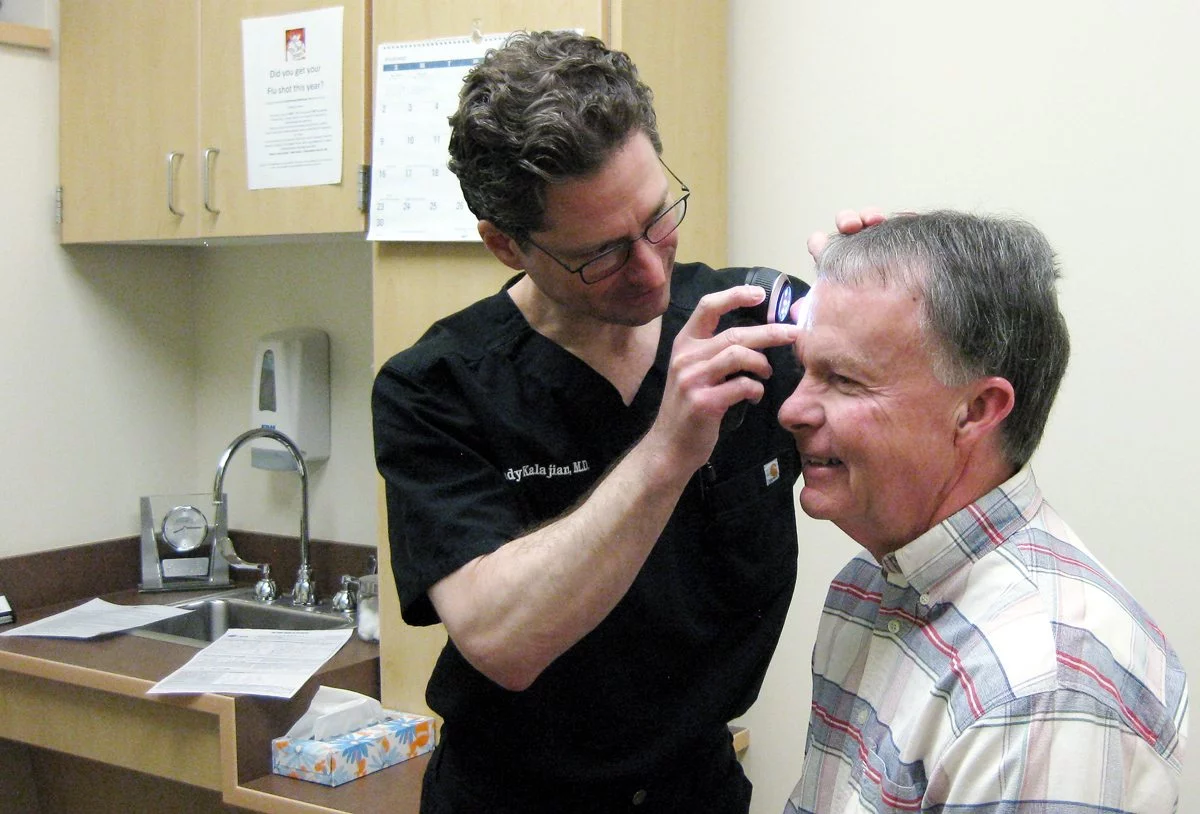
Sunblock had not been around that long when Phil Sheridan grew up, and in those days, there wasn’t a lot of awareness about the importance of protecting skin from harmful UV rays.
“I used to start the summer with a burn to get that tan going,” Sheridan said.
But as he got older, his perspective changed — as did his skin.
Sheridan knew that his lack of skin care in his younger days, combined with his fair complexion and Irish descent, meant he had a predisposition for skin cancer. He’d actually had a few spots removed in the past by his primary care doctor. So when he read about the UCHealth Aspen Club’s free, annual skin cancer screening event, he decided he’d check it out.
That was over 15 years — and several dozen cancerous growths — ago.
Benefits of annual skin cancer screening
“With Colorado’s altitude, sunny days and so many active people enjoying the incredible outdoors, paying attention to the sun’s effects on our skin is critically important,” said Jill Taylor, now retired supervisor of UCHealth Community Health in northern Colorado, who organized the free screening for several decades. “On average, more than 300 people each year have taken advantage of this community free screening — in recognition of Skin Cancer Awareness Month. In some years, more than 50% of the attendees have been found to have some form of skin damage detected. Screenings like this can be lifesavers.”
There are four types of skin cancer: actinic keratosis, basal cell carcinoma, squamous cell carcinoma and melanoma. Most people have heard of melanoma, as it is the most dangerous of skin cancers. The most common are basal cell carcinoma, and that is what a local dermatologist found 10 years ago during Sheridan’s first free screening.
Luckily for Sheridan, non-melanoma skin cancers (basal cell carcinoma, actinic keratosis, and squamous cell carcinoma) are highly curable, according to UCHealth Oncologist and Hematologist Dr. Miho Scott.

“The best way to detect skin cancer early is to recognize new or changing skin growths, particularly those that look different from other moles,” she said. “All major areas of the skin should be examined regularly.”
Although Sheridan evaluated his own skin, he realized the benefits of a dermatologist conducting the screening and following up with any concerns.
UCHealth Oncologist and Hematologist Dr. Ross McFarland said that non-melanoma skin cancer appears in areas where the skin has been consistently or severely exposed to the sun, such as the head and neck, shoulders, forearms, and back of hands. Melanoma can occur in other places, such as between the toes or upper thighs – areas not normally exposed to the sun.
Anyone with a family history of skin cancer, a large number of dark moles (greater than 50), or a history of an atypical mole should get checked annually by a trained health care provider, he said. Someone with a personal history of skin cancer should continue to monitor their own skin throughout the year.
“It’s helpful to have a loved one, spouse or friend help because you can’t see everything, such as your back, but what you can see, you should look for those ABCDEs,” McFarland said.
ABCDEs of skin cancer screening
Asymmetry – one half of the mole doesn’t match the other half.
Border irregularity – the edges are ragged, notched or blurred.
Color – the pigmentation is not uniform, with variable degrees of brown black, red, blue, gray or white.
Diameter – areas greater than 6 millimeters (the size of a pencil eraser).
Evolution – a mole that is changing in size, color, shape, or the appearance of a new lesion
“Almost all cases of basal cell and squamous cell skin cancer can be cured, especially if the cancer is detected and treated early,” Scott said.
Treatment for skin cancer
Most early skin cancers can be treated by removing the growth through several methods, from freezing to surgical removal.
For Sheridan, he’s had most of his removed by freezing or cutting, with a few being deep enough to require stitches, he said. And though it was sometimes uncomfortable to have them removed, it was never painful, he said.
“I wanted to be aggressive and have (cancerous lesions) removed because I didn’t want them to grow,” he said. “I’ve been fortunate that none of them have become serious.”
Sheridan’s run-in with skin cancer hasn’t changed the fact that he loves the outdoors. He continues to volunteer as a park ranger at Rocky Mountain National Park, hike and play tennis and golf. He is always aware of how he protects his skin.
When going outdoors, apply sunscreen with a sun protection factor (SPF) of at least 30, and wear a wide-brimmed hat, sun-protecting clothing and sunglasses.
“I love being outdoors, and my skin issues have not disrupted that,” Sheridan said. “I just make sure I wear long sleeves, a hat and sunscreen protection, and continue to go get screened.”
Sheridan continued with annual skin cancer screenings since this story was first published in June 2017. Those screenings resulted in two more surgeries to remove skin cancer. He now sees his dermatologist every three months for screening.
